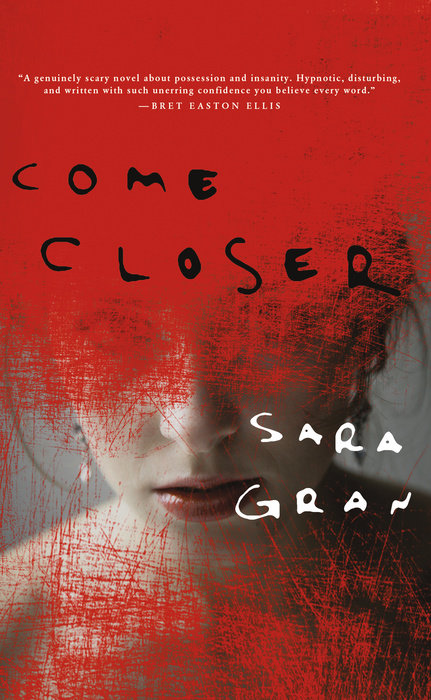There are some books that spend a long time making their way onto your to-read shelf. You choose to wait on them instead of picking them up when they’re first recommended to you, or when you first hear about them online, or when you first flip open a copy at the bookstore. They wait, looming in the background, for their appointed time.
The avoidance is rarely for nefarious reasons, of course. Usually it’s just because you’re not ‘feeling it’ at whatever particular moment–but sometimes, a book can give you the heebie-jeebies before you’ve even touched it. Sara Gran’s Come Closer is one such book for me: I was scared of this book before I read it, I was scared while I was reading it, and I remain scared of it now. It is, without a doubt, one of the best slices of horror fiction I’ve ever read.
Though it was originally published in 2003, I first encountered the book in 2012, after finishing the first of Gran’s Claire DeWitt novels and wondering what else she’d written. I must have held a copy (almost certainly the 2011 reissue from Soho Press, with its scratchy and disturbing cover) in my hands at some point, must have read the jacket copy or a synopsis somewhere, but despite loving both the Claire DeWitt books and horror fiction, I never took the leap.
Something about the title felt like–and I’m a bit embarrassed to admit this–stranger-danger. I’m a Virgo and an introvert and someone I don’t know telling me to come closer is a sure-fire way to get me to rear back. Combined with the cover, which unsettled the hell out of me, I mostly put the book mostly out of mind.

But not entirely. It lingered around the edges of my literary consciousness, that cover lurking on shelves at bookstores, the title cropping up whenever I would think about reading something new-to-me by an author I very much admire. Strangely enough, the salient detail of it being a horror novel did slide out of my brain and I developed a strange relationship to the book: someday, I told myself, I’d look into it and be surprised and whenever that day might arrive, well, I’m sure it’ll be a good day.
Fast forward to this past summer, when the book’s new UK cover caught my eye on Twitter: a different kind of intriguing (and frightening) to the US cover, one that announced to me that the time had come. I ordered it without reading a synopsis–which I recommend you do as well, curious reader. If you must, the Faber synopsis is thin and atmospheric and tells you next-to-nothing while the Soho Press jacket copy spoils several of the book’s turns (as does the rest of this essay, so stop reading here if you’d like to go in blind). Do with this information what you will.
The novel reads with unstoppable momentum. It is short, under 200 pages, and written with lean and direct prose. The reader knows something is wrong from the first page: Amanda, a well-regarded architect with a happy life, is confronted by her boss. Apparently a memo she left for him was not, in fact, the intended memo at all but instead a vitriolic homophobic screed. The issue is quickly resolved, but a question lingers: “What were you supposed to think?”
By the time you read that line, the book has its hooks in you. Quickly, we are introduced to the rest of Amanda’s world (her husband, her apartment, her routines)–and the tapping sounds she hears in the walls of the apartment. We realize very quickly that something’s wrong with Amanda, but it seems at first like burnout, exacerbated by a mouse or something. Who among us, right? We’ve all been stressed out to the point of being set off by the simplest thing, something completely innocuous like a tapping in the wall.
And that’s where the terror really sets in.
There’s a book that Amanda receives by accident called Demon Possession Past and Present and it begins with a ten-point quiz to determine the likelihood that you’re currently possessed. One of the points is hearing strange noises in your home. Another is being short-tempered. A third is having unusual new thoughts.
Again, who among us?
The fact that it’s more or less impossible to score a 0 on the quiz is one of Gran’s best tricks. By the time Amanda reads the quiz, we know that she’s possessed–even a horror neophyte will recognize that a dream about a pointy-toothed woman coming out of an eerie red ocean and asking to stay is a bad sign. But even while we shout at the page in the hopes that Amanda will wake up to her situation in time, thinking that we’d do better, Gran has seeded a crucial doubt in the reader’s mind that they too might not be entirely trustworthy. And she’s done it within the first thirty-odd pages.
The rest of the book is a full-blast descent into possession, from inside the brain of the possessed person. From that scene on the crimson shore (having recently revisited John Langan’s The Fisherman, that was the moment where all of my alarm bells started going off), there’s no question of what’s happening. This isn’t a reimagining or a reflection on possession and exorcisms; this is the real deal, ticking all the boxes and making you watch. There is violence, some of it sudden and shocking, some of it discovered only in its aftermath. It is impossible not to hope that Amanda will pull through, even as we are certain that she won’t.
This is an important element about the success of Gran’s novel: you keep reading even when you absolutely know how it’s all going to end. Readers of horror are, yes, more inclined to read to the bitter end of something vicious, but Gran’s book has devotees who rarely (if ever) touch the genre, for being self-professed scaredy-cats. Perhaps that’s down to the writing, which should replace the work of Ernest Hemingway as the standard for pared-down prose. Perhaps it’s because of the way that the book insists that you read it, so that you might get to the end and feel some relief that even though you can’t stop hearing that click-click-click in the wall, you are not possessed. It’s hard not to breathe a big sigh of relief at the end of the book that you are still alive and sane and safe.
For now, anyway.
Oh and the demon in question, who steps from red waters onto red sands with pointy teeth and kind words? It goes by the name Naamah. And while I know that Sarah Blake’s novel Naamah is purportedly about Noah’s wife and isn’t, strictly speaking, a horror story, well, I think that book has now claimed Come Closer‘s place as a book that I will warily circle for years to come, fearful and concerned that it too might hide some insidious darkness.



